Medieval (about 476AD-1600’s)
21 Arms & Armor
Andrew Gunn
Introduction
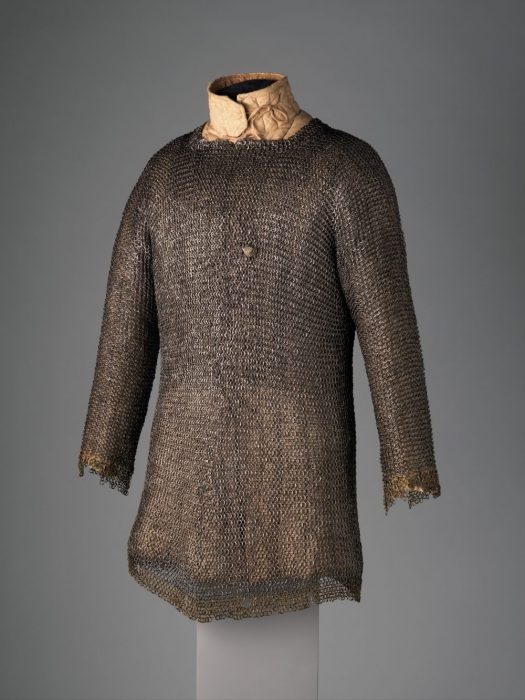
Throughout history, societal circumstances have motivated the development of many significant technologies related to warfare. Within the medieval period (400s – 1600s AD), some of the most impactful technological innovations were the advancements in armor worn on the battlefield. While the invention of chainmail predates the medieval era, it’s important to consider its impact on warfare leading into this period. Chainmail (Figure 1) can be simply described as a shirt made of interlocking metal rings designed to protect the wearer from cuts and slashes. As improvements were made upon chainmail forging methods, the diameter of the interlocking rings became smaller, and the armor more effective. The reason for this being that the smaller the diameter of the rings, the more fine-tipped a weapon mus
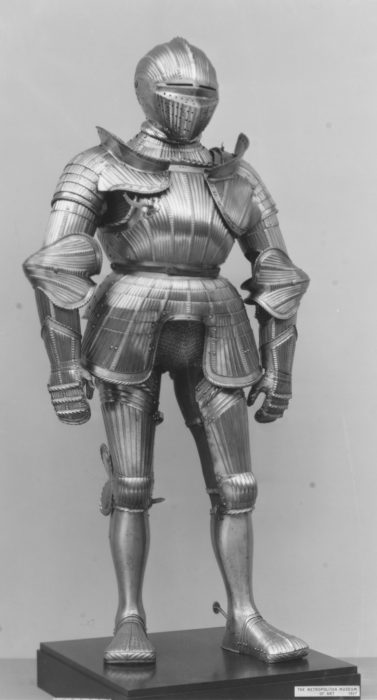
t be to pry them apart. The key result of this advancement was that it forced enemy militaries to adapt their weapon styles over time from specialized slicing weapons, to weapons designed more optimally for piercing. In the medieval era, body armor technology took another leap forward with the development of fully-plated armor (Figure 2). The tactical versatility and durability of this new armor forced a large variety of adaptations on weapon styles, combat styles, and battle formations, making it one of the most significant advancements of the medieval period.
Background
It stands to reason that as armor evolved throughout the Middle Ages, combative strategies would be adapted accordingly. With the emergence of fully plated armor, many of the light

wei
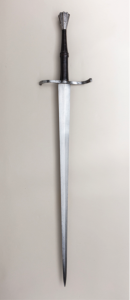
ght swords designed to pierce through enemy gambeson/chainmail became less effective. Take note of the arming sword in figure 3. Notice the tip is relatively rounded compared to the sword in figure 4. What we can gather from this observation is that the sword in figure 3 was designed more for slicing, while the sword in figure 4 was designed for thrusting. Additionally, both are relatively lightweight swords, which could have been
used with a shield if the wielder so desired. Against an opponent wearing chainmail the sword in Figure 4 would have been the better choice. The finer pointed tip makes it much easier to force in between the interlocked rings of the mail and pry them apart. However, if the opponent were a mounted, fully armored knight our analysis would become a bit more complex as there are several scenarios to consider.
Combative Strategy Against a Knight on Horseback
Mounted on a horse with a sword or lance was the most common, and also most the advantageous position in which one could find a knight on the medieval battlefield. Renowned for their skill in mounted combat, knights in the medieval era were a force to be reckoned with.Renowned for their skill in mounted combat, knights in the medieval era were a force to be reckoned with. As if a grown man covered in 3 mm thick steel-plated armor wasn’t troublesome enough, try putting him on a horse also covered in plated armor (figure 5). The armored horse would provide the knight with height, weight, and speed advantages, allowing them to drive their weapons into their opponents with more force, while also dispersing enemy formations. For this reason, battlefield tools and tactics such as jousting, pike phalanxes and gunpowder weapons were utilized with the goal of removing a knight from his horse.
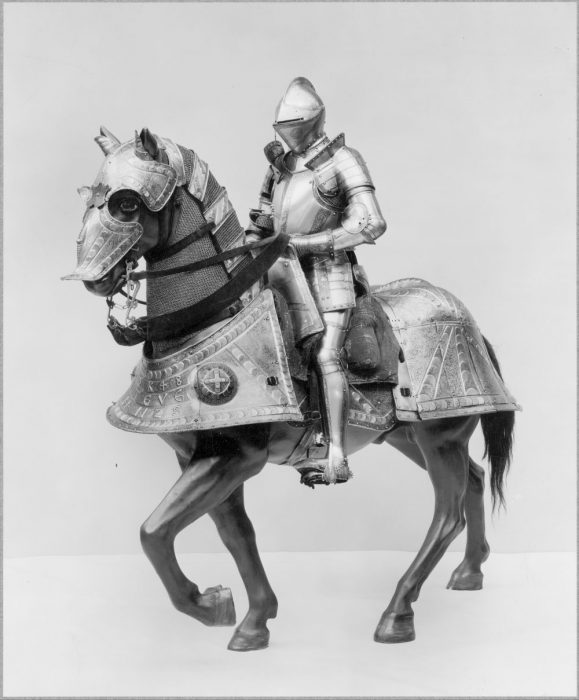
The pike phalanx (also known as the “pike square”) was generally comprised of several ranks of armored foot soldiers, each wielding pikes (figure 6) as long as 18 feet (Reinhardt, 2009). Figure 7 shows some higher-end pikeman armor probably worn by an officer, but the general style is the topic of main importance here, as well as the implications. While a majority of soldiers wore plated armor, a minority of them actually wore fully plated armor. This was a privilege typically reserved for knights. Notice that the pikeman armor below leaves exposed the arms, the face and most of the legs.


Pike formations were pretty effective in halting the advances of mounted knights and were also used in support of one’s own allied cavalry. The objective of these pikemen would be to either kill the enemy knights, or knock them off their horses, allowing other foot soldiers to finish them off. Until the late medieval period, handheld firearms were not very widely utilized because they took a while to reload and were not very accurate. Field cannons, however, were used with a fair degree of success because they did not require much accuracy due to the largeness of the projectiles they fired. For this reason, they were often used as siege engines for attacking castles (Lorge, 2011). It wasn’t until the early 16th century that handheld firearm technology had advanced enough to become meaningful on the battlefield. With this advancement, pike formations evolved into “pike and shot” formations, where the pikemen would protect the unarmored “musketeers” behind them. These musketeers, carrying early unevolved versions of the musket, would unleash volleys of heavy gunfire at armored soldiers in hopes piercing the armor, knocking them off their horse, or killing them outright, while relying on the protection of the pikemen in order to safely reload.
Combative Strategy Against a Knight on Foot
With the exception of firearms, which were used very sparingly for a majority of the middle ages, there were not very many weapons on the medieval battlefield capable of completely piercing through a knight’s thick steel armor. Plated armor made from even the poorest quality steel was usually sturdy enough to serve its purpose.Plated armor made from even the poorest quality steel was usually sturdy enough to serve its purpose. The few soldiers who actually managed this (usually with something like a lance or a pole axe) learned very quickly that this was not a desirable outcome. Because the armor and weapons were often both made of the same material, and also due to the density of the material, if a soldier did manage to pierce through the armor, the weapon would often get stuck, while still failing to pierce deep enough to deal significant damage. Additionally, a gambeson and chainmail were usually worn underneath for protection against unusually deep cuts. For these reasons attempting to pierce the armor directly with handheld weapons proved to be a less than ideal strategy.
Although fully plated armor provided many advantages, the men wearing them were not invincible, especially if on foot. If a knight found himself dismounted from his horse, enemy soldiers would often target the gaps in the armor located at the joints (armpits, crotch, neck, etc.), which were intentionally left exposed to enable movement. A common method used to exploit these weaknesses was to force the knights into close combat styles of fighting (such as grappling) where short-bladed weapons such as daggers and short swords could be used effectively. If the knight could be brought to the ground, both the weight and restrictiveness of his armor would put him at a disadvantage, and an unarmored opponent could finish them off relatively easily. You can think of this scenario as a wrestling match where the loser would get stabbed.
Soldiers equipped with arming swords or long swords such as those in figures 3 and 4 respectively, might have utilized ”half-swording” techniques against armored knights. This is another great combat adaptation example, as these techniques were developed especially for combat against armored opponents. In general practice, one hand grips the sword just below cross guard, while the other is placed roughly halfway down the blade. This grip grants more control over the tip of the blade while thrusting, and would facilitate the targeting of the exposed regions of the armor. If the situation called for it, soldiers would sometimes hold their sword by the blade with both hands and bludgeon their opponent with the pommel. The cross guard could also be used as a means of tripping the opponent. These techniques were effective with just about any hand held weapon, but were most often employed with swords (Talhoffer, 2014).
If one didn’t feel inclined to wrestle these well-trained warriors, there were several other methods of taking them down on foot. While it was impossibly difficult to pierce through the plated armor, a much more viable alternative was to cave it in (causing concussions, contusions, internal bleeding, etc.) by hitting it with a heavier weapon such as the mace in figure 9. Additionally, long heavy weapons such as halberds (figure 8) and pole axes were relatively effective at bludgeoning the opponent while keeping them at a distance.
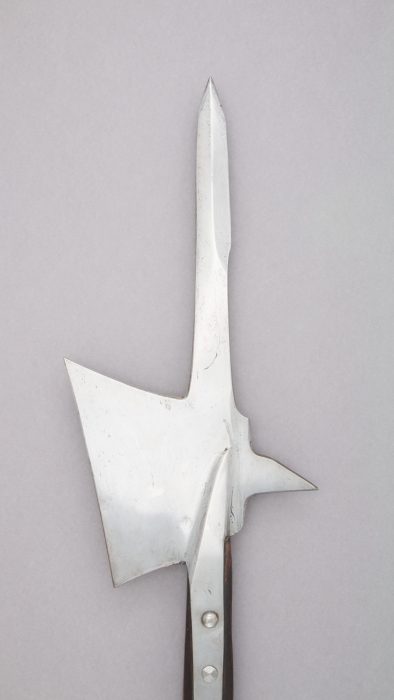
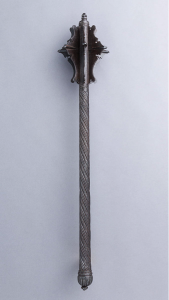
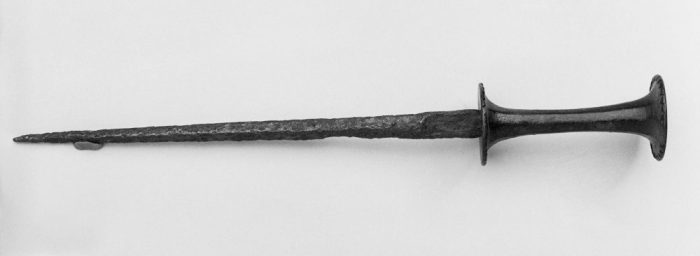
Out of the weapon types listed, the dagger, such as that shown in figure 10, was arguably the most lethal against armored soldiers. The shorter blade length allowed for the most precision while thrusting, and thus was ideal for targeting the eyeholes in the helmet, as well as the neck. Another thing to note is that if a knight were found vulnerable anywhere on the battlefield (on his back or restrained in some manner) , a dagger was frequently used to deal an efficient finishing blow. Plated armor wasn’t nearly as heavy or encumbering as it is often rumored. It never required a crane, or any extreme measure for a knight to mount his horse (Breiding, 2004). However, the armor was still very restrictive, making it difficult to get up from a prone position. For this reason (unless they were very lucky) , knocking over a knight in battle was effectively the same as killing him. There were even occurrences where groups of several people would ambush the knight, grabbing him and holding him down until the last man stabbed him.There were even occurrences where groups of several people would ambush the knight, grabbing him and holding him down until the last man stabbed him. As cruel and/or gruesome as some of these scenarios may sound, one should realize that these extreme measures really highlight the impact that these armored knights had on the battlefield. Having to send 4-5 men just to take out one is quite the inconvenience.
The Greatsword
Another noteworthy weapon, which became more common due to the integration of plated armor, was the greatsword (figure 11). A huge advantage of having plated armor was that shields were less of a necessity, so soldiers were able to use large two-handed weapons with less concern about defense.

In the late middle ages and early renaissance, greatswords were wielded as a counter to pike squares. This role was carried out dominantly by Swiss and German mercenary forces (Reisläufer and Lantknecht respectively) , usually on opposing sides of any given conflict since these two mercenary groups were bitter rivals (Reinhardt, 2009). Within the ranks of these mercenaries, the largest, heaviest of men (receiving double payment) would run to the front of the formation with these massive two-handed swords, with which they would attempt to smash, splinter, and/or knock back the pikes of the enemy formation. The signature sword of choice for the “Doppelsöldner” (which translates to “double-pay men”) was the Zweihänder (figure 14). It would not have been uncommon for these “double-pay men” to have been intercepted by enemy “double-pay men” before reaching the rows of enemy pikes. The result of this was an absolute mess!
“A brutal battle royal between the two double pay units. Not the clean puncture wound of a pike, but a ghastly harvest of body parts, blood and brains”(Reinhardt, 2009). “A brutal battle royal between the two double pay units. Not the clean puncture wound of a pike, but a ghastly harvest of body parts, blood and brains” (Reinhardt, 2009). This is depicted in Figure 12. While the risk was certainly great, if a skilled unit of Doppelsöldner were able to create an opening in the enemy ranks, they could certainly affect the outcome of a battle.

RANGED WEAPONS
While close range combat styles were most popular in medieval combat, ranged weapons were just as effective as melee (close contact combat) weapons as they allowed for the wielder to launch projectiles at their enemy before they posed an immediate threat. Early ranged weapons include “javelins, throwing axes, the bow and arrow, and medieval siege engines like catapults, ballistas and trebuchets” (American International, 2025).

When looking at the use of the crossbow in the medieval time period, it was mainly used where the topography was not favorable to support a full armored elite. There were three types of bows that were used based on the type of combat the archers were faced with: recurve bows, crossbows, and longbows. The recurve bow was less commonly used in battle as they were not as powerful as the other two but they were easy and fast to reload and aim. The crossbow and the longbow were both very powerful options that could reach a greater distance. The disadvantages of the crossbow were that it had a slower rate of fire and lacked the same mobility to be used in shorter distances. On the other hand, the longbow was limited by the strength of the archer and required much more extensive training. For this reason, the crossbow was the preferred weapon for this type of combat.
These crossbows were capable of killing mounted opponents and were cheap and easy to master. These archers were protected by spearmen that would participate in close combat in order to give the archers the best chance to incapacitate their enemy; the arrows did not always penetrate the armor, but incapacitated the enemy. It was a common strategy to leave the opponent alive as prisoners could be ransomed for money or leveraged for political influence (Knighton, 2019). While the idea of keeping prisoners for economic gain has changed since the medieval times, the concept of keeping opponents from returning to battle has been utilized and altered over time, emphasizing the protection of the prisoners of war (POWs) (NPS, 2022).
THE TRANSITION TO FIREARMS
Many people think that the age of knights came to an end with the invention of firearms, but that’s not true. The invention of gunpowder weapons did not mean the end of medieval knights. While gunpowder weapons allowed inexperienced peasants to fight against knights with years of experience, knights and gunpowder weapons existed together on the battlefield for hundreds of years.
Early firearms were designed as an extension of copper bell making. The specialists who were chosen to operate early artillery, some of whom were women, were usually not soldiers. These women became some of the first cannon operators. Soldiers disliked these specialists, and due to their tactics being seen as “unchivalrous” they were usually immediately killed if captured. These early copper cannons were incredibly dangerous, and often exploded, killing their operators. One of the more famous accidental cannon deaths was James II, who was struck by fragments from his own cannon exploding during the siege on Roxburgh Castle. But despite these early shortcomings, the growing popularity of cannons and firearms forced defenders to change tactics. Castle walls which had previously been flat were now designed with curved walls, in order to lessen the impact of artillery.
The copper cannon barrels were replaced with the less brittle bronze and iron. By 1380, artillery had become a major force on the battlefield, not only due to its mile long range but psychological impact due to such a loud instrument.
The widespread use of firearms caused massive changes in armor and battlefield tactics, and over the course of the 100 year war between England and France from 1337 to 1453, guns had come to replace most of the traditional siege weapons. And as cannons became capable of longer ranges, the need for mounted knights became less.
Smaller handheld firearms were created as a cheaper alternative to the cannon, but they still required one person to aim while another lit the fuse. What started out as a simple tube in which ammunition was packed down onto gunpowder became more refined in the 1470s, when Germans added a wooden butt and matchstick igniting method, allowing one person to fire it. These early firearms could penetrate a knight’s armor at close range, but due to the inaccuracy and slow firing rate it wouldn’t be until the 15th century when their widespread use caused knights to accept that firearms were here to stay (Kinard, 2007).
Conclusion
The technological advancements from chainmail to plate armor in the medieval era induced significant adaptations of battle tactics and weapon utilization in the interest of societal preservation. These adaptations carried into the renaissance period, where the sufficient advancement of firearms slowly but surely obsoleted steel-plated full-body armor on the battlefield. It wouldn’t be a stretch to say that plated armor was a significant influence in motivating the advancement of firearm technology. The progression of this technology eventually incentivized the research and development of the lightweight, high tensile strength polymers used in many variations of body armor worn today.
Chapter Questions
- Multiple Choice: How would one classify the sword in figure 3?
a) Long Sword
b) Short Sword
c) Arming Sword
d) War Sword - Multiple Choice: Which of the following was an effective weapon/tactic used to defeat a knight?
a) The Pike Square
b) Jousting
c) Knocking him off of his horse
d) All of the above - Short Response: What types of modern body armor are used today and how do they differ from the chainmail and plate armor utilized in the medieval period?
references
American International. (2025). Medieval Weapons. Medievalwarfare.info. https://www.medievalwarfare.info/weapons.htm
Breiding, Dirk H. (2004). Arms and Armor—Common Misconceptions and Frequently Asked Questions. Metropolitan Museum of Art: Heilbrunn Timeline of Art History. Retrieved from http://www.metmuseum.org/toah/hd/aams/hd_aams.htm
Kinard. (2007). Artillery : an illustrated history of its impact. ABC-CLIO. https://ebookcentral.proquest.com/lib/clemson/reader.action?docID=291207&ppg=1#
Knighton, A. (2019, January 22). Medieval Weapons That Maimed and Killed | HISTORY. HISTORY.
https://www.history.com/articles/medieval-weapons-knights-middle-ages
Lorge, P. (2011). Development and Spread of Firearms in Medieval and Early Modern Eurasia. History Compass, 9(10), 818–826. doi: 10.1111/j.1478-0542.2011.00802.x
National Park Service. (2022, October 26). History and Legal Status of Prisoners of War – Andersonville National Historic Site (U.S. National Park Service). Www.nps.gov. https://www.nps.gov/ande/learn/historyculture/history-legal-status-pows.htm
Reinhardt, H. (2009). The book of swords. Riverdale, NY: Baen Pub. Enterprises.
Talhoffer, H., & Rector, M. (2014). Medieval combat: a fifteenth-century illustrated manual of swordfighting and close-quarter combat. Barnsley, South Yorkshire: Frontline Books, an imprint of Pen & Sword Books Ltd.
images
“Shirt of Mail” by The Metropolitan Museum is in the Public Domain, CC0
“Armor” by The Metropolitan Museum is in the Public Domain, CC0
“Sword ca. 1450” by The Metropolitan Museum is in the Public Domain, CC0
“Sword possibly ca. 1500” by The Metropolitan Museum is in the Public Domain, CC0
“Armor for Man and Horse” by The Metropolitan Museum is in the Public Domain, CC0
“Pike” by The Metropolitan Museum is in the Public Domain, CC0
“Pikeman’s Armor” by The Metropolitan Museum is in the Public Domain, CC0
“Halberd” by The Metropolitan Museum is in the Public Domain, CC0
“Mace ca. 1550-1600” by The Metropolitan Museum is in the Public Domain, CC0
“Roundel Dagger” by The Metropolitan Museum is in the Public Domain, CC0
“Vier Zweihänder im historischen Museum Basel” by Christoph Bracher is in the Public Domain
“Bad War” by Hans Holbein the Younger is in the Public Domain
“Ballista” by Pearson Scott Foresman is in the Public Domain

